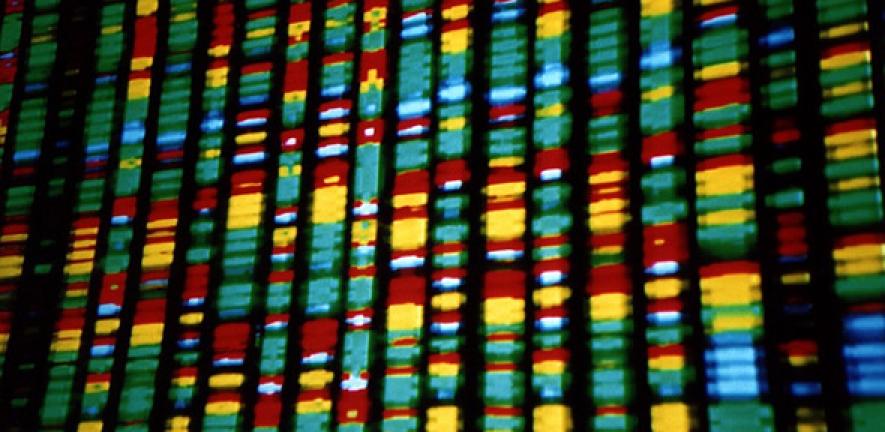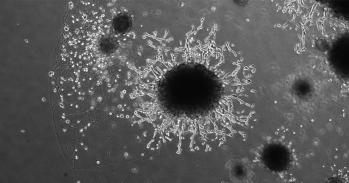
A rare DNA base, previously thought to be a temporary modification, has been shown to be stable in mammalian DNA, suggesting that it plays a key role in cellular function.
A rare DNA base, previously thought to be a temporary modification, has been shown to be stable in mammalian DNA, suggesting that it plays a key role in cellular function.
This will alter the thinking of people in the study of development and the role that these modifications may play in the development of certain diseases
Shankar Balasubramanian
Researchers from the University of Cambridge and the Babraham Institute have found that a naturally occurring modified DNA base appears to be stably incorporated in the DNA of many mammalian tissues, possibly representing an expansion of the functional DNA alphabet.
The new study, published today (22 June) in the journal Nature Chemical Biology, has found that this rare ‘extra’ base, known as 5-formylcytosine (5fC) is stable in living mouse tissues. While its exact function is yet to be determined, 5fC’s physical position in the genome makes it likely that it plays a key role in gene activity.
“This modification to DNA is found in very specific positions in the genome – the places which regulate genes,” said the paper’s lead author Dr Martin Bachman, who conducted the research while at Cambridge’s Department of Chemistry. “In addition, it’s been found in every tissue in the body – albeit in very low levels.”
“If 5fC is present in the DNA of all tissues, it is probably there for a reason,” said Professor Shankar Balasubramanian of the Department of Chemistry and the Cancer Research UK Cambridge Institute, who led the research. “It had been thought this modification was solely a short-lived intermediate, but the fact that we’ve demonstrated it can be stable in living tissue shows that it could regulate gene expression and potentially signal other events in cells.”
Since the structure of DNA was discovered more than 60 years ago, it’s been known that there are four DNA bases: G, C, A and T (Guanine, Cytosine, Adenine and Thymine). The way these bases are ordered determines the makeup of the genome.
In addition to G, C, A and T, there are also small chemical modifications, or epigenetic marks, which affect how the DNA sequence is interpreted and control how certain genes are switched on or off. The study of these marks and how they affect gene activity is known as epigenetics.
5fC is one of these marks, and is formed when enzymes called TET enzymes add oxygen to methylated DNA – a DNA molecule with smaller molecules of methyl attached to the cytosine base. First discovered in 2011, it had been thought that 5fC was a ‘transitional’ state of the cytosine base which was then being removed from DNA by dedicated repair enzymes. However, this new research has found that 5fC can actually be stable in living tissue, making it likely that it plays a key role in the genome.
Using high-resolution mass spectrometry, the researchers examined levels of 5fC in living adult and embryonic mouse tissues, as well as in mouse embryonic stem cells – the body’s master cells which can become almost any cell type in the body.
They found that 5fC is present in all tissues, but is very rare, making it difficult to detect. Even in the brain, where it is most common, 5fC is only present at around 10 parts per million or less. In other tissues throughout the body, it is present at between one and five parts per million.
The researchers applied a method consisting of feeding cells and living mice with an amino acid called L-methionine, enriched for naturally occurring stable isotopes of carbon and hydrogen, and measuring the uptake of these isotopes to 5fC in DNA. The lack of uptake in the non-dividing adult brain tissue pointed to the fact that 5fC can be a stable modification: if it was a transient molecule, this uptake of isotopes would be high.
The researchers believe that 5fC might alter the way DNA is recognised by proteins. “Unmodified DNA interacts with a specific set of proteins, and the presence of 5fC could change these interactions either directly or indirectly by changing the shape of the DNA duplex,” said Bachman. “A different shape means that a DNA molecule could then attract different proteins and transcription factors, which could in turn change the way that genes are expressed.”
“This will alter the thinking of people in the study of development and the role that these modifications may play in the development of certain diseases,” said Balasubramanian. “While work is continuing in determining the exact function of this ‘extra’ base, its position in the genome suggests that it has a key role in the regulation of gene expression.”
The research was supported by Cancer Research UK, the Wellcome Trust and the Biotechnology and Biological Sciences Research Council UK.

The text in this work is licensed under a Creative Commons Attribution 4.0 International License. For image use please see separate credits above.




